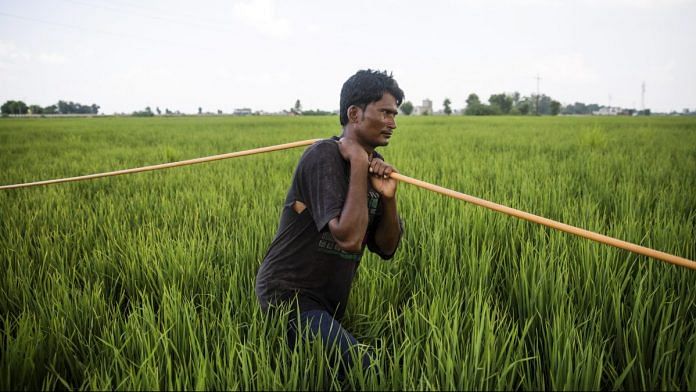Statistics show that in overall, India’s farmers are doing far better than many realize. Instead of loan waivers, policy makers need to peel through the layers to figure out what farmers really need.
It’s election season in India and the money is flowing. Governments in many states have begun waiving tens of millions of dollars’ worth of loans to poor farmers in an effort to buy their loyalty. The argument – widely accepted by politicians and journalists, the demographic groups with the least fiscal instinct – is that India’s farmers are buckling under the weight of their debts and rural suicides are spiking dangerously. Rural households are desperate for relief.
The numbers tell a different story. And, given the detrimental impact on credit discipline, not to mention the hole such waivers are going to blow in state budgets, politicians would be wise to rethink their plans.
According to India’s National Crime Records Bureau, the number of farmers committing suicide has actually been falling in recent years; fewer such deaths were recorded in 2016 than at any time in the previous 16 years. Nearly twice as many Indian housewives commit suicide as farmers do.
Nor does there seem to be a clear link between farmer suicides and poverty. Suicide mortality rates are higher in the relatively wealthy states of Maharashtra and Andhra Pradesh than in poorer Bihar and Uttar Pradesh. If one examines the incidence of indebtedness – the percentage of households that owe money to banks or moneylenders – it’s true that poorer farmers tend to owe more. They have a much higher debt-to-asset ratio and hold more formal and informal loans than richer households do.
But they’re not the ones killing themselves: According to data from the National Sample Survey Office, nearly 90 percent of the farmers who committed suicide in Maharashtra owned more than two acres of land. Six out of 10 owned more than four acres.
Also read: Why higher MSPs don’t really help the Indian farmer in the long run
This defies the centuries-old stereotype of rail-thin farmers laboring to pay back fat, greedy and unscrupulous moneylenders – a trope that can be found everywhere from the 1957 Bollywood hit “Mother India” to the dry pages of Reserve Bank of India reports. The overriding objective behind most of the government’s subsidized credit schemes since the 1950s has been to provide alternatives to these usurers. States such as Bihar where moneylenders hold more sway, though, tend to see fewer suicides. In high-suicide Maharashtra, formal loans account for 87 percent of total outstanding debt – far above the national average of 57 percent.
Overall, too, India’s farmers are doing far better than many realize. One way to gauge the well-being of rural households is to look at how much they’re buying: They now account for 45 percent of the fast-moving consumer goods sector in India. This is remarkable given the vast disparity in disposable incomes between urban and rural households, and it implies that improvements in rural infrastructure, connectivity and digitization are translating into higher demand. Over the last three years, rural sales grew significantly faster than urban sales in both volume and value; consumption growth currently stands at a robust 9.7 percent.
What policymakers need to realize, first, is that India has no single rural economy. It’s always possible to find distressed households somewhere. But they may fall in the bottom quintiles, or perhaps in specific states of the country or perhaps even among the rich farmers of Mehrauli, near Delhi. More targeted programs would address the problem more effectively and far more cheaply than blanket loan waivers.
Second, loans are clearly not the only source of farmer distress. While “indebtedness” has been rising as a cause of farmer suicides since the government began measuring them separately in 2014, the most commonly cited causes of suicide in India historically have been “family problems” or “illness.” The latter especially has seldom received enough policy attention in the past decades. Access to healthcare, as well as to rural infrastructure, obviously plays a role in determining how optimistic and secure farmers feel.
Each of these issues requires a different prescription. As agricultural productivity and output improve, for instance, and India grows more food-secure, farmers are inevitably going to face lower prices. The most effective and least distortionary way to support them would be through direct benefit transfers. The new National Health Protection Mission (“Ayushman Bharat”) should improve rural healthcare. Free LPG connections for poor households should lower their energy burdens while improving the respiratory health of women (smoke from cooking fires is a leading cause of death in many parts of India).
What is abundantly clear is that loan waivers aren’t the panacea they’re made out to be politically. Those who want to help India’s farmers should be working much harder to figure out what they really need. – Bloomberg
Also read: If we can afford to recapitalise banks and a bullet train, why not MSP for farmers?







Loan waivers are not made out to be a panacea for farmers. It is just a starting point and has to be coupled with other Government action. The author needs to understand that clearly . I would very seriously doubt his co-relation of FMCG items with the farmers. It would be good if the author figured out the average land holding of the so called farmer who does not realize how well off he is. then as a simple exercise approach an Agricultural University and ascertain the maximum possible income such a farmer can obtain – given 100 % land quality – 100 % water and weather – No pests. then assuming that such factors never get together for a poor farmer , cut the maximum output by 30 % to 40 % and then let us see if the author can survive on this amount . We can talk about suicides later. Finally remember the distribution of land holdings has a long tail towards below average land holdings